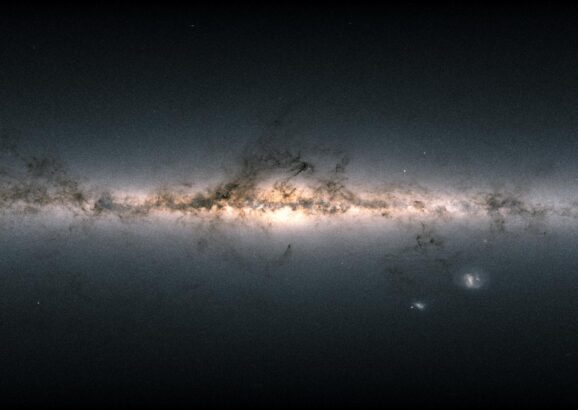Lina Necib PhD '17
Research Interests
As a theoretical astroparticle physicist, I work on using Galactic dynamics to understand properties of Dark Matter. I use cosmological simulations, stellar catalogs, machine learning techniques, and a background of particle physics to build the first map of Dark Matter in the Milky Way.
- Galactic Dynamics – Using Gaia, I modeled the kinematics of accreted stars, some of which originate from particular merger events, such as the Gaia Sausage/Gaia Enceledus. I also discovered a new structure, called Nyx, after the Greek Goddess of the night.
- Telescopes – I analyzed various telescope data to understand the kinematics of stars, and how it plays with Dark Matter kinematics. For example, the Fermi Telescope, and the Sloan Digital Sky Survey.
- Collider Physics – I worked on implementing methods to distinguish particular events at the Large Hadron Collider from backgrounds. Such methods were used by the experiments to set limits on hypothetical Dark Matter particles.
- Simulations – I used a variety of hydrodynamic simulations, FIRE, Eris, and Illustris, to correlate Dark Matter with observables.
- Model Building – I built a few Dark Matter models, for example Boosted Dark Matter, and studied how it can be detected in Neutrino Experiments.
Biographical Sketch
Professor Necib is an astroparticle physicist, interested in understanding the origin of Dark Matter. She uses a combination of simulations and observational data to correlate the dynamics of Dark Matter with that of the stars in the Milky Way, and infer properties of Dark Matter. She has investigated the local dynamic structures in the Solar neighborhood using the Gaia, and contributed to building a catalog of local accreted stars using machine learning techniques. She has also discovered a new stream called Nyx after the Greek Goddess of the Night, and is using spectroscopy to identify its properties. Professor Necib is interested in using Gaia in conjunction with other spectroscopic surveys to understand the Dark Matter profile in the local solar neighborhood, the center of the Galaxy, and in dwarf galaxies. With a background in particle physics, Professor Necib relates the empirical results of Dark Matter to current direct and indirect detection experiments.
Professor Necib is originally from Tunisia. She moved to the US in 2008 to attend Boston University, where she obtained a Bachelor of Arts in Mathematics and Physics in 2012. She then obtained a PhD in theoretical physics from MIT, under the supervision of Professor Jesse Thaler. Subsequently, she moved to California where she was a Sherman Fairchild fellow at Caltech from 2017 to 2020, a Presidential Fellow at the University of California Irvine in 2020, and a Fellow in Theoretical Astrophysics at Carnegie Observatories 2020-2021. Finally, she joins MIT faculty in July 2021.
More info:

Study: Stars travel more slowly at Milky Way’s edge
The findings suggest our galaxy’s core may contain less dark matter than previously estimated.
Awards & Honors
- 2024 // Sloan Research Fellow
- 2024 // NSF Early Career Development Award
- 2023 // George E. Valley, Jr. Prize (APS) "For the discovery of a massive, previously unknown stellar structure that may have shaped the history of the Milky Way, and the development of groundbreaking new methods to study our Galaxy's dark matter halo and growth history."
- 2020-2021 // Carnegie Observatories Theoretical Astrophysics Fellow
- 2020 // University of California Irvine Presidential Fellowship
- 2017-2020 // Sherman Fairchild Postdoctoral Fellowship, California Institute of Technology
- 2016 // Sergio Vazquez Prize, MIT
- 2012 // Praecis Presidential Graduate Fellowship, MIT
Key Publications
-
Lina Necib, Bryan Ostdiek, Mariangela Lisanti, Timothy Cohen, Marat Freytsis, Shea Garrison-Kimmel, Philip F. Hopkins, Andrew Wetzel, Robyn Sanderson.
Evidence for a Vast Prograde Stellar Stream in the Solar Vicinity. Nature Astronomy (2020). -
Lina Necib, Mariangela Lisanti, Shea Garrison-Kimmel, Andrew Wetzel, Robyn Sanderson, Philip F. Hopkins, Claude-André Faucher-Giguère, Dušan Kereš.
Under the Firelight: Stellar Tracers of the Local Dark Matter Velocity Distribution in the Milky Way. ApJ 883 no 1. 27. -
Lina Necib, Mariangela Lisanti, Vasily Bolokurov.
Inferred Evidence for Dark Matter Kinematic Substructure with SDSS-Gaia. ApJ 874 no.3, 22. -
Jonah Herzog-Arbeitman, Mariangela Lisanti, Lina Necib.The Metal-Poor Stellar Halo in RAVE-TGAS and its Implications for the Velocity Distribution of Dark Matter. JCAP 1804 052.
-
Jonah Herzog-Arbeitman, Mariangela Lisanti, Piero Madau, Lina Necib.Empirical Determination of Dark Matter Velocities using Metal-Poor Stars. PRL 120 no.4, 041102.